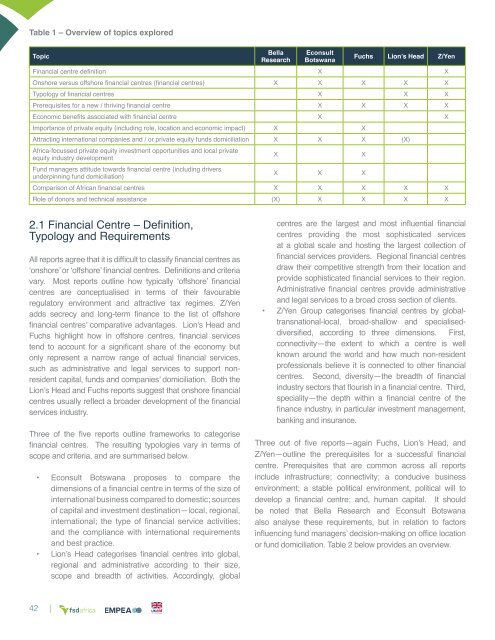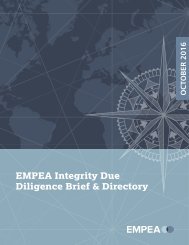You also want an ePaper? Increase the reach of your titles
YUMPU automatically turns print PDFs into web optimized ePapers that Google loves.
Table 1 – Overview <strong>of</strong> topics explored<br />
Topic<br />
Bella<br />
Research<br />
Econsult<br />
Botswana<br />
Fuchs Lion’s Head Z/Yen<br />
Financial centre definition X X<br />
Onshore versus <strong>of</strong>fshore financial centres (financial centres) X X X X X<br />
Typology <strong>of</strong> financial centres X X X<br />
Prerequisites for a new / thriving financial centre X X X X<br />
Economic benefits associated with financial centre X X<br />
Importance <strong>of</strong> private equity (including role, location and economic impact) X X<br />
Attracting international companies and / or private equity funds domiciliation X X X (X)<br />
Africa-focussed private equity investment opportunities and local private<br />
equity industry development<br />
X<br />
X<br />
Fund managers attitude towards financial centre (including drivers<br />
underpinning fund domiciliation)<br />
X X X<br />
Comparison <strong>of</strong> African financial centres X X X X X<br />
Role <strong>of</strong> donors and technical assistance (X) X X X X<br />
2.1 Financial Centre – Definition,<br />
Typology and Requirements<br />
All reports agree that it is difficult to classify financial centres as<br />
‘onshore’ or ‘<strong>of</strong>fshore’ financial centres. Definitions and criteria<br />
vary. Most reports outline how typically ‘<strong>of</strong>fshore’ financial<br />
centres are conceptualised in terms <strong>of</strong> their favourable<br />
regulatory environment and attractive tax regimes. Z/Yen<br />
adds secrecy and long-term finance to the list <strong>of</strong> <strong>of</strong>fshore<br />
financial centres’ comparative advantages. Lion’s Head and<br />
Fuchs highlight how in <strong>of</strong>fshore centres, financial services<br />
tend to account for a significant share <strong>of</strong> the economy but<br />
only represent a narrow range <strong>of</strong> actual financial services,<br />
such as administrative and legal services to support nonresident<br />
capital, funds and companies’ domiciliation. Both the<br />
Lion’s Head and Fuchs reports suggest that onshore financial<br />
centres usually reflect a broader development <strong>of</strong> the financial<br />
services industry.<br />
Three <strong>of</strong> the five reports outline frameworks to categorise<br />
financial centres. The resulting typologies vary in terms <strong>of</strong><br />
scope and criteria, and are summarised below.<br />
• Econsult Botswana proposes to compare the<br />
dimensions <strong>of</strong> a financial centre in terms <strong>of</strong> the size <strong>of</strong><br />
international business compared to domestic; sources<br />
<strong>of</strong> capital and investment destination—local, regional,<br />
international; the type <strong>of</strong> financial service activities;<br />
and the compliance with international requirements<br />
and best practice.<br />
• Lion’s Head categorises financial centres into global,<br />
regional and administrative according to their size,<br />
scope and breadth <strong>of</strong> activities. Accordingly, global<br />
centres are the largest and most influential financial<br />
centres providing the most sophisticated services<br />
at a global scale and hosting the largest collection <strong>of</strong><br />
financial services providers. Regional financial centres<br />
draw their competitive strength from their location and<br />
provide sophisticated financial services to their region.<br />
Administrative financial centres provide administrative<br />
and legal services to a broad cross section <strong>of</strong> clients.<br />
• Z/Yen Group categorises financial centres by globaltransnational-local,<br />
broad-shallow and specialiseddiversified,<br />
according to three dimensions. First,<br />
connectivity—the extent to which a centre is well<br />
known around the world and how much non-resident<br />
pr<strong>of</strong>essionals believe it is connected to other financial<br />
centres. Second, diversity—the breadth <strong>of</strong> financial<br />
industry sectors that flourish in a financial centre. Third,<br />
speciality—the depth within a financial centre <strong>of</strong> the<br />
finance industry, in particular investment management,<br />
banking and insurance.<br />
Three out <strong>of</strong> five reports—again Fuchs, Lion’s Head, and<br />
Z/Yen—outline the prerequisites for a successful financial<br />
centre. Prerequisites that are common across all reports<br />
include infrastructure; connectivity; a conducive business<br />
environment; a stable political environment, political will to<br />
develop a financial centre; and, human capital. It should<br />
be noted that Bella Research and Econsult Botswana<br />
also analyse these requirements, but in relation to factors<br />
influencing fund managers’ decision-making on <strong>of</strong>fice location<br />
or fund domiciliation. Table 2 below provides an overview.<br />
42 |





